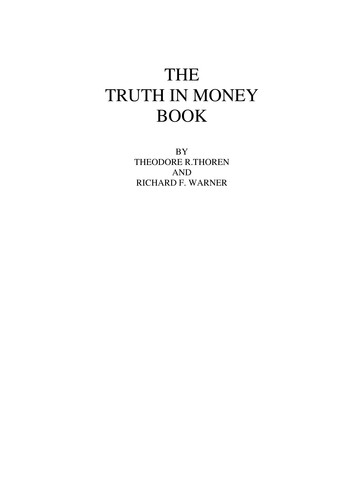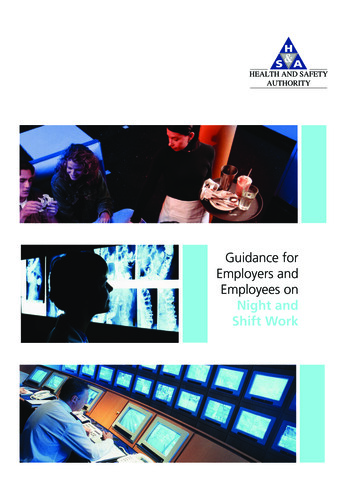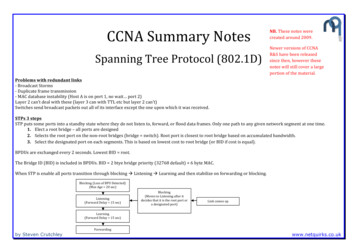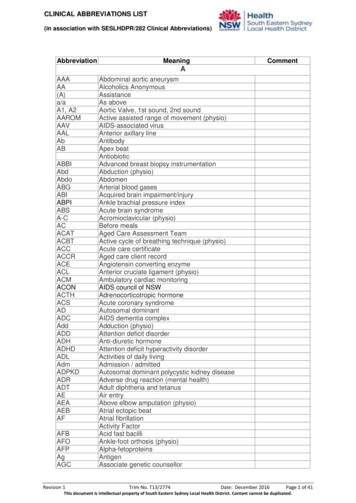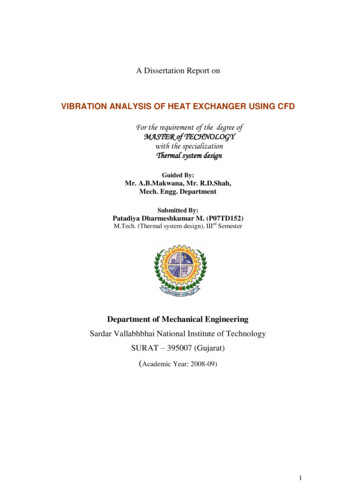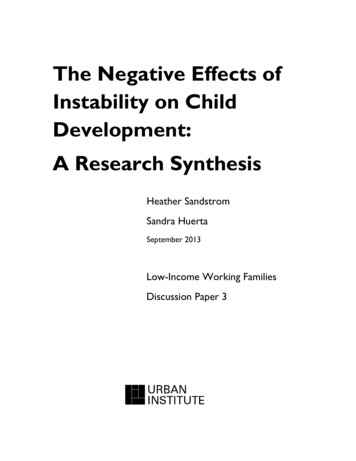
Transcription
The Negative Effects ofInstability on ChildDevelopment:A Research SynthesisHeather SandstromSandra HuertaSeptember 2013Low-Income Working FamiliesDiscussion Paper 3
Copyright September 2013. The Urban Institute. All rights reserved. Except for short quotes, nopart of this report may be reproduced in any form or used in any form by any means, electronic ormechanical, including photocopying, recording, or by information storage or retrieval system,without written permission from the Urban Institute.This report is part of the Urban Institute’s Low-Income Working Families project, a multiyear effortthat focuses on the private- and public-sector contexts for families’ success or failure. Both contextsoffer opportunities for better helping families meet their needs. The Low-Income Working Familiesproject is currently supported by the Annie E. Casey Foundation.The authors thank Gina Adams and Lisa Dubay for their tremendous support in creating this paperand for their ongoing input in the writing process. They also thank Margaret Simms and Julia Isaacsfor their extensive review and comments which shaped the final draft.The nonpartisan Urban Institute publishes studies, reports, and books on timely topics worthy ofpublic consideration. The views expressed are those of the authors and should not be attributed tothe Urban Institute, its trustees, or its funders.
ContentsExecutive Summary4What Do We Know about Instability?4What Are the Effects of Various Types of Instability on Child Development?5Implications for Policy and Practice7The Negative Effects of Instability on Child Development9What Do We Mean by Instability?10Why Does Instability Matter?12Theoretical Framework13Economic Instability15Employment Instability21Family Instability24Residential Instability28Instability in Out-of-Home Contexts: School and Child Care32The Role of Parenting and Parental Mental Health among Unstable Families38Conclusions40Notes46References47About the Authors57
4Executive SummaryChildren’s early experiences shape who they are and affect lifelong health and learning. To developto their full potential, children need safe and stable housing, adequate and nutritious food, access tomedical care, secure relationships with adult caregivers, nurturing and responsive parenting, andhigh-quality learning opportunities at home, in child care settings, and in school.Research shows that a large number of children face instability in their lives. Researchersfrom various fields of study—developmental psychology, sociology, economics, public policy,demography, and family studies—have independently explored different domains of instability inthe supportive structures that predict children’s outcomes. However, little effort has been made tolook across research disciplines and study contexts to synthesize our knowledge base and drawconnections among the various domains of instability. In this synthesis paper, we build thisknowledge base by exploring the extant literature on the effects of instability on children’sdevelopmental outcomes and academic achievement.In our discussion, we review and synthesize research evidence on five identified domains ofinstability that have been well established in the literature: family income, parental employment,family structure, housing, and the out-of-home contexts of school and child care. In our review ofthe evidence, we also discuss some of the key pathways through which instability may affectdevelopment. Specifically, research points to the underlying role of parenting, parental mentalhealth, and the home environment in providing the stability and support young children need forpositive development. We conclude with recommendations for policy and practice to alleviate theimpact of instability. This examination will serve as a resource to policymakers and practitionersconcerned with programs and services for children and families, and build a foundation for futureresearch in this area.What Do We Know about Instability?The term instability is often used in social science research to reflect change or discontinuity in one’sexperience; however, operational definitions of instability vary by field and are often determined bythe data and measures available for research. Whereas some literature looks at the effects of changemeasured broadly, change itself can have both positive and negative implications depending on thecontext, including whether the change is voluntary, planned in advance, and moving the individual
5or family to better circumstances. For our purposes, instability is best conceptualized as theexperience of change in individual or family circumstances where the change is abrupt, involuntary,and/or in a negative direction, and thus is more likely to have adverse implications for childdevelopment.Changes do not occur in isolation but rather a disruption in one domain (e.g., parentemployment) often triggers a disruption in another domain (e.g., child care) in a “domino effect”fashion. In some cases, the causality of instability is not one-dimensional but a result of acomplicated series of events that compound over time. This domino effect may be most evidentamong low-income or lower middle-class families who lack savings and assets that they can tap intoduring temporary periods of transition (McKernan, Ratcliffe, and Vinopal 2009; Mills and Amick2010).Children thrive in stable and nurturing environments where they have a routine and knowwhat to expect. Although some change in children’s lives is normal and anticipated, sudden anddramatic disruptions can be extremely stressful and affect children’s feeling of security. Within thecontext of supportive relationships with adults who act as a buffer against any negative effects ofinstability, children learn how to cope with adversity, adapt to their surroundings, and regulate theiremotions (National Scientific Council on the Developing Child 2007). When parents lack choice orcontrol over change, they may be less likely to support their children in adapting to the change.“Unbuffered” stress that escalates to extreme levels can be detrimental to children’s mental healthand cognitive functioning (Evans, Brooks-Gunn, and Klebanov 2011; Shonkoff and Garner 2011).What Are the Effects of Various Types of Instability on ChildDevelopment?Economic Instability The experience of economic instability causes increased material hardship, particularly whenfamilies lack personal assets.Low family income negatively affects children’s social-emotional, cognitive, and academicoutcomes, even after controlling for parental characteristics.Children’s cognitive development during early childhood is most sensitive to the experienceof low family income.Literature on the effects of economic instability on child development is limited, thoughthere are bodies of literature on economic instability, and on the relationship betweenpoverty and child development.
6Employment Instability Parental employment instability is linked to negative academic outcomes, such as graderetention, lower educational attainment, and internalizing and externalizing behaviors.The effect on grade retention is strongest for children with parents with a high schooleducation or less, whereas the effect on educational attainment is stronger for blacks thanwhites, males, and first-born children.In dual-income households, a father’s job loss may be more strongly related to children’sacademic outcomes than a mother’s job loss.Job instability leads to worse child behavioral outcomes than when a parent voluntarilychanges jobs, works low-wage jobs full-time, or has fluctuating work hours.Family Instability Family instability is linked to problem behaviors and some academic outcomes, even at earlyages.Children’s problem behaviors further increase with multiple changes in family structure.Family transitions that occur early in children’s development, prior to age 6, and inadolescence appear to have the strongest effects. While young children need constantcaregivers with whom they can form secure attachments, adolescents need parental support,role models, and continuity of residence and schools to succeed.Children demonstrate more negative behaviors when they lack the emotional and materialsupport at home that they need to smoothly handle a family transition.Residential Instability Children experiencing residential instability demonstrate worse academic and socialoutcomes than their residentially-stable peers, such as lower vocabulary skills, problembehaviors, grade retention, increased high school drop-out rates, and lower adult educationalattainment.Academically, elementary school children appear to be the most sensitive to residentialchange as compared with younger, non-school-age children and older children, butresidential instability is related to poor social development across age groups.Home and neighborhood quality may mediate the effect of residential instability on childrenas housing moves lead to changes in children’s environments.Instability in Out-of-Home Contexts: School and Child Care Changes in schools and child care arrangements are common, particularly as families moveor change jobs, but school mobility and child care instability are most prevalent among lowincome families.For infants, changes in child care arrangements can lead to poor attachment with providersand problem behaviors. For preschoolers, early care and education settings supportchildren’s development of foundational school readiness skills; changes in care settings can
7 disrupt the continuity of learning. For school-age children, changes in schools impedechildren’s academic progress and decrease social competence.School mobility has the strongest effect during early elementary and high school, withmultiple school transfers leading to worse effects.What More Do We Need to Learn about Instability? Few studies systematically examine the effect of a short-term decrease in household incomeon child development, particularly among average income earners who might not necessarilyfall into poverty during these short-term decreases. Additional research is needed tounderstand the level of income change and duration of economic instability that make adifference in children’s developmental outcomes. Research suggests the importance of interconnections between domains, such as familystructure, employment, housing, and child care. However, few studies to date include abroader view of instability to understand patterns of multiple changes and the combinedeffects on children. Additional research is needed that explores instability in multipledomains and how simultaneous events interact, trigger instability in other areas, and affectchild outcomes. More studies looking across developmental periods are also needed to fully understand howvarious types of instability affect children at different ages and when instability matters most.This information has implications for the design of policies and practices that can targetchildren and families experiencing instability. A challenging issue with this research is that the reason for change and whether changes areunpredictable and unplanned as opposed to intentional are unclear. There is a strong needfor further research that clearly distinguishes the effects of voluntary and involuntarychanges across various family domains.Learning innovative strategies or methods from programs serving children and familiesfacing instability is an important next step. For example, lessons from programs that servespecial populations of unstable families, such as migrant workers or military familiesexperiencing chronic mobility and family separation, might help us understand some of theunique experiences and needs of families experiencing instability and effective approaches tohelp them cope. Implications for Policy and PracticeThis research has important policy implications for programs that serve and support families withchildren. Having systems and policies in place in early childhood programs and schools to identifyfamilies who are experiencing a lot of changes is one method to target extra services and casemanagement. Given the central role parents play in how children are affected in the long-term,
8additional efforts could be made to target parental mental health and parental skill-building. Welldesigned, two-generational intervention programs aimed at supporting positive parenting, reducingparental and childhood stress, and strengthening family coping strategies can ease the impact ofinstability on children.Although parents are primary in assuring their children’s well-being and healthydevelopment, a broad range of government programs also play an important role, especially forchildren in low-income families. Safety net programs provide financial assistance to families in theform of cash payments or subsidized housing, child care, or food, all of which help to alleviate theimmediate effects of instability. But the programs might be able to do more to stabilize the situationfor children, by considering whether any administrative practices inadvertently increase instability.Simplified reporting procedures, longer eligibility periods, and a single, centralized eligibility processfor multiple programs are some potential strategies.
9The Negative Effects of Instability on Child DevelopmentChildren’s early experiences shape who they are and affect lifelong health and learning. To developto their full potential, children need safe and stable housing, adequate and nutritious food, access tomedical care, secure relationships with adult caregivers, nurturing and responsive parenting, andhigh-quality learning opportunities at home, in child care settings and in school.The recent financial crisis of the Great Recession has taken a negative toll on families acrossthe country and beyond. High parental unemployment, home foreclosures, and strained householdresources have weakened the stability and quality of home environments for many children andlimited access to proper care and nutrition. As parents struggle to provide financially for theirfamilies, the chronic stress they face may make it difficult for them to give their children the careand attention they need. Some children who have grown up during this time period haveexperienced a great deal of instability in their lives. This lack of security and continuity can havedeep and lasting impacts on children’s development physically, emotionally, and cognitively.Although instability has been a longstanding issue for some families, its increased prevalenceduring the recession has heightened awareness of the issue. Coupled with recent advances in thestudy of toxic stress and its adverse effects on child development (National Scientific Council on theDeveloping Child 2007), there is a growing need to understand what it means for children toexperience instability and how any negative effects can be prevented.Bodies of research from various fields of study—developmental psychology, sociology,economics, public policy, demography and family studies—independently explore different domainsof instability in the supportive structures that predict children’s outcomes. However, there has beenlittle effort to look across research disciplines and study contexts to synthesize the knowledge baseand draw connections among the various domains of instability.In this synthesis paper, we build this knowledge base by exploring the literature on theeffects of instability on children’s developmental outcomes and academic achievement. In ourdiscussion, we review and synthesize research evidence on five identified domains of instability thathave been well established in the literature: family income, parental employment, housing, familystructure, and the out-of-home contexts of school and child care.1 We also discuss some of the keypathways through which instability may affect development. Specifically, research points to theunderlying role of parenting, parental mental health, and the home environment in providing the
10stability and support young children need for positive development. We conclude withrecommendations for policy and practice to alleviate the impact of instability. This examination willserve as a resource to policymakers and practitioners concerned with programs and services forchildren and families, and build a foundation for future research in this area.What Do We Mean by Instability?The term instability is often used in social science research to reflect change or discontinuity in one’sexperience; however, operational definitions of instability vary by field and are often determined bythe data and measures available for research. Whereas some literature looks at the effects of changemeasured broadly, change itself can have both positive and negative implications depending on thecontext, including whether the change is voluntary, planned in advance, or moving the individual orfamily to better circumstances. For the purposes of this synthesis, instability is best conceptualized asthe experience of abrupt, involuntary, and/or negative change in individual or family circumstances,which is likely to have adverse implications for child development. Examples include a fatherunexpectedly losing his job and income, a residential move as a result of foreclosure, and thedissolution of a parental union. When parents lack choice or control over change, they may be lessable to support their children in adapting to the change.Instability has been studied from various angles, with the underlying theme that certain kindsof change, and changes at certain points in their lives, predict negative outcomes for children(Moore, Vandivere, and Ehrle 2000). These changes do not occur in isolation. A disruption in onedomain (e.g., parent employment) often triggers a disruption in another domain (e.g., child care) in a“domino effect” fashion. In some cases, the causality of instability is not one-dimensional but aresult of a complicated series of events that compound over time. This domino effect may be mostpredominant among low-income or lower middle-class families who lack savings and assets that theycan tap into during temporary periods of transition (McKernan, Ratcliffe, and Vinopal 2009; Millsand Amick 2010). The relationships among different domains are complex and involve a balancingact, such as cutting back or giving more to some domains to maintain overall stability for the family.The conceptual framework displayed in figure 1 illustrates how the various domains ofinstability under examination in this paper are interconnected. For example, employment instabilityis connected to economic instability, since parental employment and family income are directlyrelated. Family economics are also connected to the family structure and housing. As parents
11separate or form new unions, a family may change residences and the household income may vary.A change in residence may lead to a change in schools or child care providers, which may also varyas a result of changes in parental employment or income. The domains of instability are depicted asoverlapping circles that form an outer ring around the child, who is at the center of the model.Parenting and the home environment act as a buffer between instability and the child. When they arepositive and supportive, parents can protect the child from the effects of instability; however,instability can potentially weaken the quality of parenting and the home environment, thus negativelyinfluencing the child.Figure 1. Conceptual Framework of the Effects of Instability on Children andthe Supportive Role of Parenting and the Home EnvironmentThis literature synthesis does not directly examine the interrelationships across domains, butit does highlight how these domains are related. Because of methodological challenges, few studies
12consider changes across multiple domains and how they relate to each other and to children’sdevelopment across the life span. Another key challenge is disentangling the effects of familyincome from the effects of instability in a given domain, since instability is somewhat more frequentamong low-income families, and poverty itself has a strong negative association with childdevelopment (Brooks-Gunn and Duncan 1997; Brooks-Gunn, Duncan, and Maritato 1997).Specifically, research suggests there are two forms of instability: chronic instability that is inherent ofbeing low-income and episodic instability that occurs from external shocks, such as a job loss orparental divorce. This synthesis includes literature that demonstrates that both forms of instabilityare negatively associated with children’s developmental outcomes.More generally, while some literature on instability attempts to estimate the causal impacts ofinstability on children, other studies are more descriptive in nature, documenting associations thatmay or may not be causal. It is thus difficult to identify the leading causes of the instability and howtargeted external supports can alleviate the effects of instability. This synthesis advances the study ofinstability by drawing together disparate literatures on the effects of instability in different domainsand identifying common themes across multiple domains in how instability relates to children’sdevelopment.Why Does Instability Matter?Children thrive in stable and nurturing environments where they have a routine and generally knowwhat to expect from their daily lives. Although some change in children’s lives is normal andanticipated, sudden and dramatic disruptions can be extremely stressful and affect children’s feelingof security. Within the context of supportive relationships with adults who act as a buffer against anynegative effects of instability, children learn how to cope with adversity, adapt to their surroundings,and regulate their emotions (National Scientific Council on the Developing Child 2007). Unbufferedstress, however, that escalates to extreme levels can be detrimental to children’s mental health andcognitive functioning (Evans, Brooks-Gunn, and Klebanov 2011; Shonkoff and Garner 2011).Recent research from the National Scientific Council on the Developing Child shows thatexperiencing some stress is normal and even essential for healthy development (2007). Youngchildren deal with emotionally stressful situations everyday: an infant separates from his mother onthe first day of child care, a toddler argues with a peer over a preferred toy, or a preschooler gets ashot at the doctor’s office. Such common events produce positive stress, characterized by brief
13increases in heart rate and mild elevations in stress hormone levels. Human bodies are built torespond to environmental stress in ways that protect us from harm. Even more moderate levels ofstress, such as the loss of a pet, are viewed by experts as being tolerable for children when bufferedby supportive adults.Yet children exposed to strong, frequent, and/or prolonged adversity, or toxic stress, are atrisk for cognitive impairment and stress-related disease (2007). Toxic stress causes an over-activationof the stress response system so the body is constantly in a heightened state of arousal, whichdisrupts normal brain and organ development and, consequently, damages brain architecture andneurocognitive systems. The result is poor academic performance, a lack of social competence, andan inability to regulate emotions. Even adult cognitive abilities have been shown to be impaired inpart by elevated chronic stress during childhood (Evans and Schamberg 2009).Although it may not be clear how much stress is tolerable, when stress becomes toxic, andhow these levels vary across individuals, it is evident that extreme forms of stress can have lastingimpacts on development. Moreover, supportive relationships with adults are necessary for childrento recover from distressing life events. Most transitions in children’s lives do not provoke stress at atoxic level; however, this emerging body of research raises the question of what we know about theimpact of more pervasive stress stemming from instability. The research also highlights how stressmay be a mechanism through which instability affects development.Theoretical FrameworkGrounding our review of the research literature within an existing theoretical framework can helpshape the way we conceptualize instability and the effects it has on children and families. Threeselected research theories each contribute to our understanding of how environmental factorsinfluence young children’s experiences within their families.The first is the family stress theory (McCubbin and Patterson 1983; Patterson 2002), whichis often applied in the fields of family studies and psychology. This theory suggests that three factorsinteract to predict the likelihood of a crisis or the inability to maintain stability: a stressful event, afamily’s perception of the stressor, and a family’s existing resources. If the family has the resourcesto handle the burden of the stressor, then a crisis can be avoided. During difficult life circumstances,families implement coping strategies, such as turning to their support networks and community
14resources, to effectively manage the stress. Effective coping, or family resiliency, leads to adaptationthat can restore balance to the family’s functioning. However, some families experience a “pile-up”of stress when they have difficulties coping and managing change, which can lead to maladaptationand poor family functioning over time.To build on that theory and explore how family functioning relates to children’s outcomes,we turn to Bronfenbrenner’s ecological systems theory (1979). According to this framework,multiple and complex layers of social contexts influence and support children’s development,although “the family is the principal context in which human development takes place” (1986, p.723). When children are engaged in positive interactions with their caregivers, children are morecapable of meeting their full potential (e.g., high competence, low problem behaviors)(Bronfenbrenner and Ceci 1994). However, when interactions are negative or absent, then children’scapacities are not realized and they demonstrate more difficulties. Under this framework, we wouldview parents’ roles as buffering their children from the negative effects of stress and stimulatingpositive development through active engagement and sensitive caregiving.A third theory, the parent investment model (Mayer 1997), more closely identifies the typesof parental contributions to their children. According to this model, children’s success depends onthe time, money, energy, and support their parents invest in their “human capital.” From thisperspective, parents foster children’s development by providing them with a safe and stimulatinghome environment and engaging and supporting them in learning opportunities inside and outsideof home. Family income influences children’s development by way of parents’ decisions about howto allocate their resources. The money families spend on their children, such as the purchasing oftoys, books, and learning materials for the home or enrollment in higher quality child care andextracurricular activities, are investments that contribute to positive child outcomes. The time andenergy spent on children are also important investments. Families with lower financial resources thatcannot physically provide for their children may be able to compensate in other ways that do notrequire additional spending. Moreover, cultural endowments, such as the value parents place oneducation, work, and service, contribute to children’s motivation to learn and to give back to society.Under this framework, we would posit that instability may hinder parents’ ability to provide for theirchildren in multiple ways—economically and emotionally. However, parental motivation and highexpectations may help to drive children to overcome the challenges of limited resources.
15Researchers often integrate two or more of these theories to provide a more comprehensiveframework for understanding how the interplay between family stress and parental investmentsshape children’s developmental outcomes and future adult potential (see Conger 2005; Whittaker etal. 2011). The overarching view is that, when parents face extremely stressful life situations and areunable to effectively cope, their ability to provide the necessary resources and support for theirchildren is constrained. Their children then experience a great deal of unbuffered stress—potentiallytoxic stress, in the most extreme cases—and have more difficulties reaching their full potential,academically and socially. This research synthesis draws from these frameworks as we examine howinstability in children’s lives, marked by stressful life events, lead to adverse outcomes.Economic InstabilitySummary of Key Findings The experience of economic instability causes increased material hardship,particularly when families lack personal assets.Low family income negatively affects children’s social-emotional, cognitive,and academic outcomes, even after controlling for parental characteristics.Children’s cognitive development during early childhood is most sensitive tothe experience of low family income.Literature on the effects of economic instability on child development islimited, though there are bodies of literature on economic instability, and onthe relationship between poverty and child development.Economic instability—also referred to as income instability or economic insecurity—describes adrop in family income from which families may or may not recover. Family income can include jobearnings, public income support, such as temporary cash assistance, and private income support,such as child support (Mills and Amick 2010). Though economic instability is directly tied toinstability in other family domains (i.e., parental employment, family structure), in th
residential instability is related to poor social development across age groups. Home and neighborhood quality may mediate the effect of residential instability on children as housing moves lea

